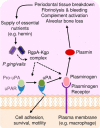Porphyromonas gingivalis-derived RgpA-Kgp Complex Activates the Macrophage Urokinase Plasminogen Activator System: IMPLICATIONS FOR PERIODONTITIS
- PMID: 25979345
- PMCID: PMC4481207
- DOI: 10.1074/jbc.M115.645572
Porphyromonas gingivalis-derived RgpA-Kgp Complex Activates the Macrophage Urokinase Plasminogen Activator System: IMPLICATIONS FOR PERIODONTITIS
Abstract
Urokinase plasminogen activator (uPA) converts plasminogen to plasmin, resulting in a proteolytic cascade that has been implicated in tissue destruction during inflammation. Periodontitis is a highly prevalent chronic inflammatory disease characterized by destruction of the tissue and bone that support the teeth. We demonstrate that stimulation of macrophages with the arginine- and lysine-specific cysteine protease complex (RgpA-Kgp complex), produced by the keystone pathogen Porphyromonas gingivalis, dramatically increased their ability to degrade matrix in a uPA-dependent manner. We show that the RgpA-Kgp complex cleaves the inactive zymogens, pro-uPA (at consensus sites Lys(158)-Ile(159) and Lys(135)-Lys(136)) and plasminogen, yielding active uPA and plasmin, respectively. These findings are consistent with activation of the uPA proteolytic cascade by P. gingivalis being required for the pathogen to induce alveolar bone loss in a model of periodontitis and reveal a new host-pathogen interaction in which P. gingivalis activates a critical host proteolytic pathway to promote tissue destruction and pathogen virulence.
Keywords: extracellular matrix; macrophage; periodontal disease; plasmin; plasminogen.
© 2015 by The American Society for Biochemistry and Molecular Biology, Inc.
Figures







Similar articles
-
Porphyromonas gingivalis gingipains: the molecular teeth of a microbial vampire.Curr Protein Pept Sci. 2003 Dec;4(6):409-26. doi: 10.2174/1389203033487009. Curr Protein Pept Sci. 2003. PMID: 14683427 Review.
-
Structural insights unravel the zymogenic mechanism of the virulence factor gingipain K from Porphyromonas gingivalis, a causative agent of gum disease from the human oral microbiome.J Biol Chem. 2017 Apr 7;292(14):5724-5735. doi: 10.1074/jbc.M117.776724. Epub 2017 Feb 14. J Biol Chem. 2017. PMID: 28196869 Free PMC article.
-
Role of RgpA, RgpB, and Kgp proteinases in virulence of Porphyromonas gingivalis W50 in a murine lesion model.Infect Immun. 2001 Dec;69(12):7527-34. doi: 10.1128/IAI.69.12.7527-7534.2001. Infect Immun. 2001. PMID: 11705929 Free PMC article.
-
Proteolytic Activity-Independent Activation of the Immune Response by Gingipains from Porphyromonas gingivalis.mBio. 2022 Jun 28;13(3):e0378721. doi: 10.1128/mbio.03787-21. Epub 2022 May 2. mBio. 2022. PMID: 35491845 Free PMC article.
-
The role of gingipains in the pathogenesis of periodontal disease.J Periodontol. 2003 Jan;74(1):111-8. doi: 10.1902/jop.2003.74.1.111. J Periodontol. 2003. PMID: 12593605 Review.
Cited by
-
Peptidylarginine Deiminase of Porphyromonas gingivalis Modulates the Interactions between Candida albicans Biofilm and Human Plasminogen and High-Molecular-Mass Kininogen.Int J Mol Sci. 2020 Apr 3;21(7):2495. doi: 10.3390/ijms21072495. Int J Mol Sci. 2020. PMID: 32260245 Free PMC article.
-
The Recruitment and Activation of Plasminogen by Bacteria-The Involvement in Chronic Infection Development.Int J Mol Sci. 2023 Jun 21;24(13):10436. doi: 10.3390/ijms241310436. Int J Mol Sci. 2023. PMID: 37445613 Free PMC article. Review.
-
Metabolic Remodeling, Inflammasome Activation, and Pyroptosis in Macrophages Stimulated by Porphyromonas gingivalis and Its Outer Membrane Vesicles.Front Cell Infect Microbiol. 2017 Aug 4;7:351. doi: 10.3389/fcimb.2017.00351. eCollection 2017. Front Cell Infect Microbiol. 2017. PMID: 28824884 Free PMC article.
-
Impact of low-level laser therapy as an adjunct to non-surgical periodontal treatment on the levels of tissue plasminogen activator and plasminogen activator inhibitor 1 in Stage 3-4, Grade C periodontitis patients: a split-mouth, randomized control study.Clin Oral Investig. 2023 Nov;27(11):6439-6449. doi: 10.1007/s00784-023-05248-z. Epub 2023 Sep 15. Clin Oral Investig. 2023. PMID: 37709984 Clinical Trial.
-
Transcriptomic analysis of Porphyromonas gingivalis-infected head and neck cancer cells: Identification of PLAU as a candidate prognostic biomarker.J Cell Mol Med. 2024 Feb;28(4):10.1111/jcmm.18167. doi: 10.1111/jcmm.18167. J Cell Mol Med. 2024. PMID: 38363001 Free PMC article.
References
-
- Carmeliet P., Moons L., Lijnen R., Baes M., Lemaître V., Tipping P., Drew A., Eeckhout Y., Shapiro S., Lupu F., Collen D. (1997) Urokinase-generated plasmin activates matrix metalloproteinases during aneurysm formation. Nat. Genet. 17, 439–444 - PubMed
-
- Danø K., Behrendt N., Høyer-Hansen G., Johnsen M., Lund L. R., Ploug M., Rømer J. (2005) Plasminogen activation and cancer. Thromb. Haemost. 93, 676–681 - PubMed
-
- Smith H. W., Marshall C. J. (2010) Regulation of cell signalling by uPAR. Nat. Rev. Mol. Cell Biol. 11, 23–36 - PubMed
-
- Hamilton J. A., Campbell I. K., Wojta J., Cheung D. (1992) Plasminogen activators and their inhibitors in arthritic disease. Ann. N.Y. Acad. Sci. 667, 87–100 - PubMed
Publication types
MeSH terms
Substances
LinkOut - more resources
Full Text Sources
Miscellaneous

